Microstructural Characteristics of Interfacial Zone in Asphalt Mixture Considering the Influence of Aggregates Properties
Abstract
:1. Introduction
2. Materials and Methods
2.1. Aggregate Investigation and Samples Preparation
2.2. Nanoindentation Theory
2.3. Mechanical Characteristics of Interfacial Zone
2.4. Investigation on Morphology of Interfacial Zone
3. Results and Discussion
3.1. Mechanical Properties of Interfacial Zone
3.2. Viscoelasticity States of Interfacial Zone
3.3. Microstructural States of Interfacial Zone
4. Summary and Conclusions
Author Contributions
Funding
Conflicts of Interest
References
- Zhang, Y.; Luo, X.; Onifade, I.; Huang, X.; Lytton, R.L.; Birgisson, B. Mechanical evaluation of aggregate gradation to characterize load carrying capacity and rutting resistance of asphalt mixtures. Constr. Build. Mater. 2019, 205, 499–510. [Google Scholar] [CrossRef]
- Zhang, Y.; Ma, T.; Ling, M.; Zhang, D.; Huang, X. Predicting Dynamic Shear Modulus of Asphalt Mortars Using Discretized-Element Simulation and Reinforcement Mechanisms. J. Mater. Civil Eng. 2019, 31, 040191638. [Google Scholar] [CrossRef]
- Veytskin, Y.; Bobko, C.; Castorena, C.; Kim, Y.R. Nanoindentation investigation of asphalt binder and mortar cohesion. Constr. Build. Mater. 2015, 100, 163–171. [Google Scholar] [CrossRef]
- Faisal, H.; Tarefder, R.; Weldegiorgis, M. Nanoindentation Characterization of Moisture Damage in Different Phases of Asphalt Concrete. Adv. Civ. Eng. Mater. 2015, 4, 31–46. [Google Scholar] [CrossRef]
- Tarefder, R.A.; Faisal, H.; Sobien, H. Nanomechanical Characterization Effect of Mica and Aging on Asphalt Binder. J. Mater. Civ. Eng. 2014, 26, 04014063. [Google Scholar] [CrossRef]
- Yao, Z.; Zhu, H.; Gong, M.; Yang, J.; Xu, G.; Zhong, Y. Characterization of asphalt materials’ moisture susceptibility using multiple methods. Constr. Build. Mater. 2017, 155, 286–295. [Google Scholar] [CrossRef]
- Tarefder, R.A.; Zaman, A.M.; Uddin, W. Determining Hardness and Elastic Modulus of Asphalt by Nanoindentation. Int. J. Geéomeéch. 2010, 10, 106–116. [Google Scholar] [CrossRef]
- Katsuki, D.; Gutierrez, M. Nanoindentation approach characterizing strain rate sensitivity of compressive response of asphalt concrete. Acta Geotech. 2013, 9, 887–901. [Google Scholar] [CrossRef]
- Zhang, Y.; Liu, Q.T.; Van De Ven, M.; Molenaar, A.A.A.; Wu, S.P. Identification of Rejuvenators on Porous-Asphalt Concrete Using Optical Microscopy and Nanoindentation Technology. J. Mater. Civ. Eng. 2015, 27. [Google Scholar] [CrossRef]
- Nazzal, M.D.; Mogawer, W.; Kaya, S.; Bennert, T. Multiscale Evaluation of the Composite Asphalt Binder in High–Reclaimed Asphalt Pavement Mixtures. J. Mater. Civ. Eng. 2014, 26, 04014019. [Google Scholar] [CrossRef]
- Veytskin, Y.; Bobko, C.; Castorena, C. Nanoindentation and Atomic Force Microscopy Investigations of Asphalt Binder and Mortar. J. Mater. Civil. Eng. 2016, 28, 040160196. [Google Scholar] [CrossRef]
- Xu, O.; Wang, Z.; Wang, R. Effects of aggregate gradations and binder contents on engineering properties of cement emulsified asphalt mixtures. Constr. Build. Mater. 2017, 135, 632–640. [Google Scholar] [CrossRef]
- Du, S. Influence of chemical additives on mixing procedures and performance properties of asphalt emulsion recycled mixture with reclaimed cement-stabilized macadam. Constr. Build. Mater. 2016, 118, 146–154. [Google Scholar] [CrossRef]
- Deshpande, R.R.; Das, A. Asphalt binder adsorption by aggregates: A microscopic study. Road Mater. Pavement Des. 2017, 199, 1–16. [Google Scholar] [CrossRef]
- Kuang, D.; Zhang, B.; Jiao, Y.; Fang, J.; Chen, H.; Wang, L. Impact of particle morphology on aggregate-asphalt interface behavior. Constr. Build. Mater. 2017, 132, 142–149. [Google Scholar] [CrossRef]
- Rondón-Quintana, H.; Cárdenas, J.C.R.; Farias, M.M.-D. Behavior of Hot-Mix Asphalt Containing Blast Furnace Slag as Aggregate: Evaluation by Mass and Volume Substitution. J. Mater. Civ. Eng. 2019, 31, 04018364. [Google Scholar] [CrossRef]
- Wu, J.; Wang, L.; Meng, L. Analysis of mineral composition and microstructure of gravel aggregate based on XRD and SEM. Road Mater. Pavement Des. 2017, 18, 1–10. [Google Scholar] [CrossRef]
- Yin, Y.; Chen, H.; Kuang, D.; Song, L.; Wang, L. Effect of chemical composition of aggregate on interfacial adhesion property between aggregate and asphalt. Constr. Build. Mater. 2017, 146, 231–237. [Google Scholar] [CrossRef]
- Rossi, C.O.; Caputo, P.; Baldino, N.; Lupi, F.R.; Miriello, D.; Angelico, R. Effects of adhesion promoters on the contact angle of bitumen-aggregate interface. Int. J. Adhes. Adhes. 2016, 70, 297–303. [Google Scholar] [CrossRef]
- Mohajeri, M.; Molenaar, A.A.A.; Van De Ven, M. Experimental study into the fundamental understanding of blending between reclaimed asphalt binder and virgin bitumen using nanoindentation and nano-computed tomography. Road Mater. Pavement Des. 2014, 15, 372–384. [Google Scholar] [CrossRef]
- Karki, P.; Yuya, P.A.; Kim, Y.-R.; Turner, J.A. Nanomechanical Properties of Constituent Phases in Bituminous Mixtures. J. Mater. Civ. Eng. 2016, 28, 04016090. [Google Scholar] [CrossRef]
- Zhu, X.; Yuan, Y.; Li, L.; Du, Y.; Li, F. Identification of interfacial transition zone in asphalt concrete based on nano-scale metrology techniques. Mater. Des. 2017, 129, 91–102. [Google Scholar] [CrossRef]
- Yuan, Y.; Zhu, X.; Li, L.; Wang, H. Effect of the Interfacial Zone on the Tensile-Damage Behavior of an Asphalt Mixture Containing MSWI Bottom Ash Aggregates. J. Mater. Civ. Eng. 2017, 29, 04016269. [Google Scholar] [CrossRef]
- Zhu, X. Influence of interfacial zone between asphalt mortar and aggregate on the elastic behavior of asphalt concrete. Constr. Build. Mater. 2013, 49, 797–806. [Google Scholar] [CrossRef]
- Kim, S.-M.; Abu Al-Rub, R.K. Meso-scale computational modeling of the plastic-damage response of cementitious composites. Cem. Concr. Res. 2011, 41, 339–358. [Google Scholar] [CrossRef]
- Skarzynski, L.; Nitka, M.; Tejchman, J. Modelling of concrete fracture at aggregate level using FEM and DEM based on X-ray mu CT images of internal structure. Eng. Fract. Mech. 2015, 147, 13–35. [Google Scholar] [CrossRef]
- Trawinski, W.; Bobinski, J.; Tejchman, J. Two-dimensional simulations of concrete fracture at aggregate level with cohesive elements based on X-ray mu CT images. Eng. Fract. Mech. 2016, 168, 204–226. [Google Scholar] [CrossRef]
- Fischer-Cripps, A. A simple phenomenological approach to nanoindentation creep. Mater. Sci. Eng. A 2004, 385, 74–82. [Google Scholar] [CrossRef]
- Hossain, M.; Faisal, H.; Tarefder, R.A. Characterisation and modelling of vapour-conditioned asphalt binders using nanoindentation. Int. J. Pavement Eng. 2015, 16, 382–396. [Google Scholar] [CrossRef]
- Hossain, M.I.; Faisal, H.M.; Tarefder, R.A. Determining effects of moisture in mortar materials using nanoindentation. Mater. Struct. 2016, 4949, 1079–1092. [Google Scholar] [CrossRef]
- Veytskin, Y.; Bobko, C.; Castorena, C. Nanoindentation investigation of asphalt binder and mortar viscoelasticity. Int. J. Pavement Eng. 2016, 1717, 363–376. [Google Scholar] [CrossRef]
- Khan, A.; Redelius, P.; Kringos, N. Evaluation of adhesive properties of mineral-bitumen interfaces in cold asphalt mixtures. Constr. Build. Mater. 2016, 125, 1005–1021. [Google Scholar] [CrossRef]
- Sevilla, A.B.; Montero, M.L.; Aguiar-Moya, J.P.; Loria-Salazar, L.G.; Bhasin, A. Influence of bitumen and aggregate polarity on interfacial adhesion. Road Mater. Pavement Des. 2017, 18, 1–14. [Google Scholar] [CrossRef]
- Del Bosque, I.S.; Zhu, W.; Howind, T.; Matías, A.; De Rojas, M.S.; Medina, C.; Martínez, C.M. Properties of interfacial transition zones (ITZs) in concrete containing recycled mixed aggregate. Cem. Concr. Compos. 2017, 81, 25–34. [Google Scholar] [CrossRef] [Green Version]
- Hu, J.; Qian, Z. The prediction of adhesive failure between aggregates and asphalt mortar based on aggregate features. Constr. Build. Mater. 2018, 183, 22–31. [Google Scholar] [CrossRef]
- Tang, F.; Zhu, S.; Xu, G.; Ma, T.; Kong, L.; Kong, L. Influence by chemical constitution of aggregates on demulsification speed of emulsified asphalt based on UV-spectral analysis. Constr. Build. Mater. 2019, 212, 102–108. [Google Scholar] [CrossRef]
- Tarefder, R.A.; Zaman, A.M. Nanoscale Evaluation of Moisture Damage in Polymer Modified Asphalts. J. Mater. Civ. Eng. 2010, 22, 714–725. [Google Scholar] [CrossRef]
- Tarefder, R.A.; Faisal, H. Effects of Dwell Time and Loading Rate on the Nanoindentation Behavior of Asphaltic Materials. J. Nanomech. Micromech. 2013, 3, 17–23. [Google Scholar] [CrossRef]
- Tarefder, R.; Faisal, H. Nanoindentation Characterization of Asphalt Concrete Aging. J. Nanomech. Micromech. 2014, 4. [Google Scholar] [CrossRef]
- Liu, S.; Cao, W.; Shang, S.; Qi, H.; Fang, J. Analysis and application of relationships between low-temperature rheological performance parameters of asphalt binders. Constr. Build. Mater. 2010, 24, 471–478. [Google Scholar] [CrossRef]
- Aflaki, S.; Hajikarimi, P. Implementing viscoelastic rheological methods to evaluate low temperature performance of modified asphalt binders. Constr. Build. Mater. 2012, 36, 110–118. [Google Scholar] [CrossRef]




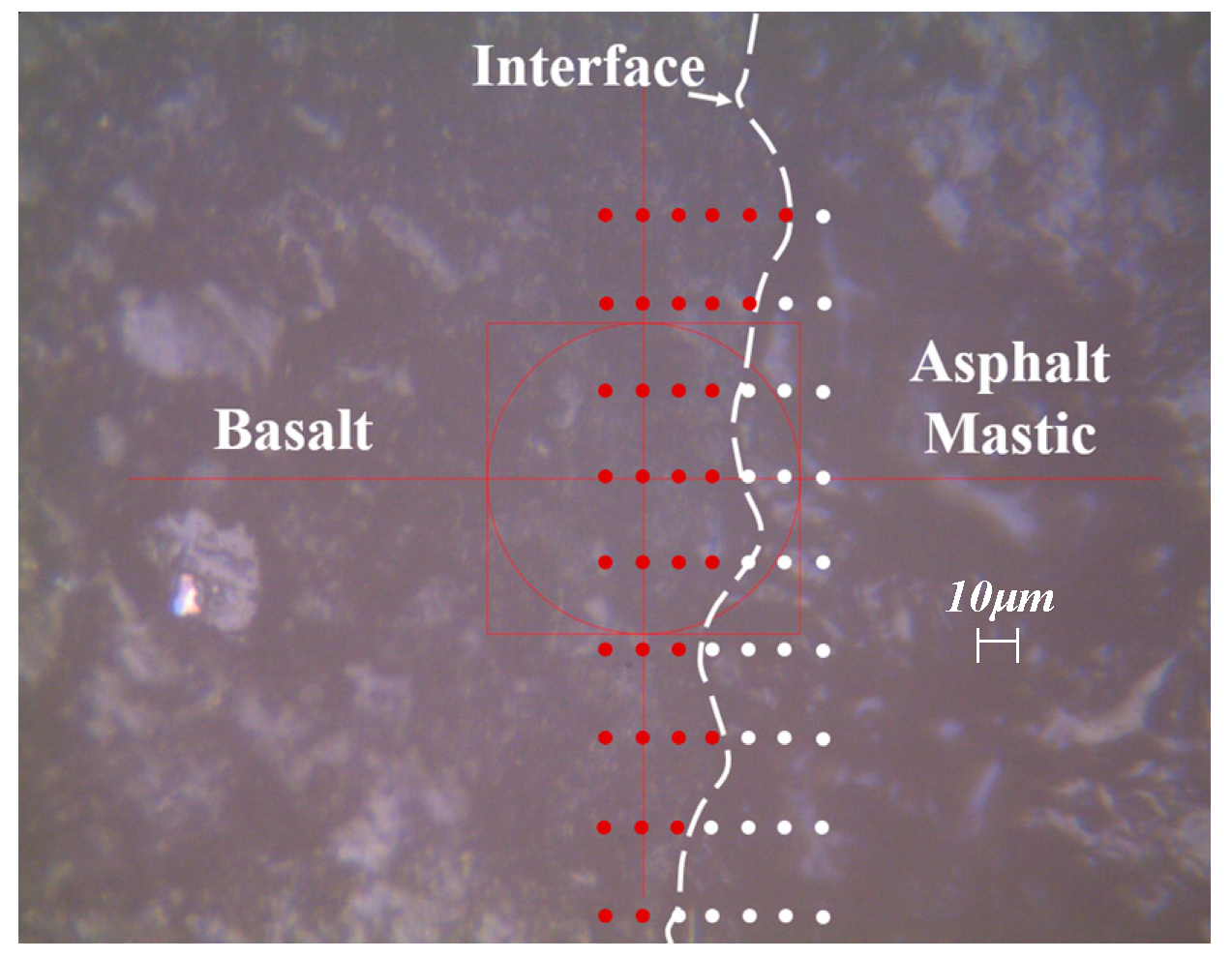

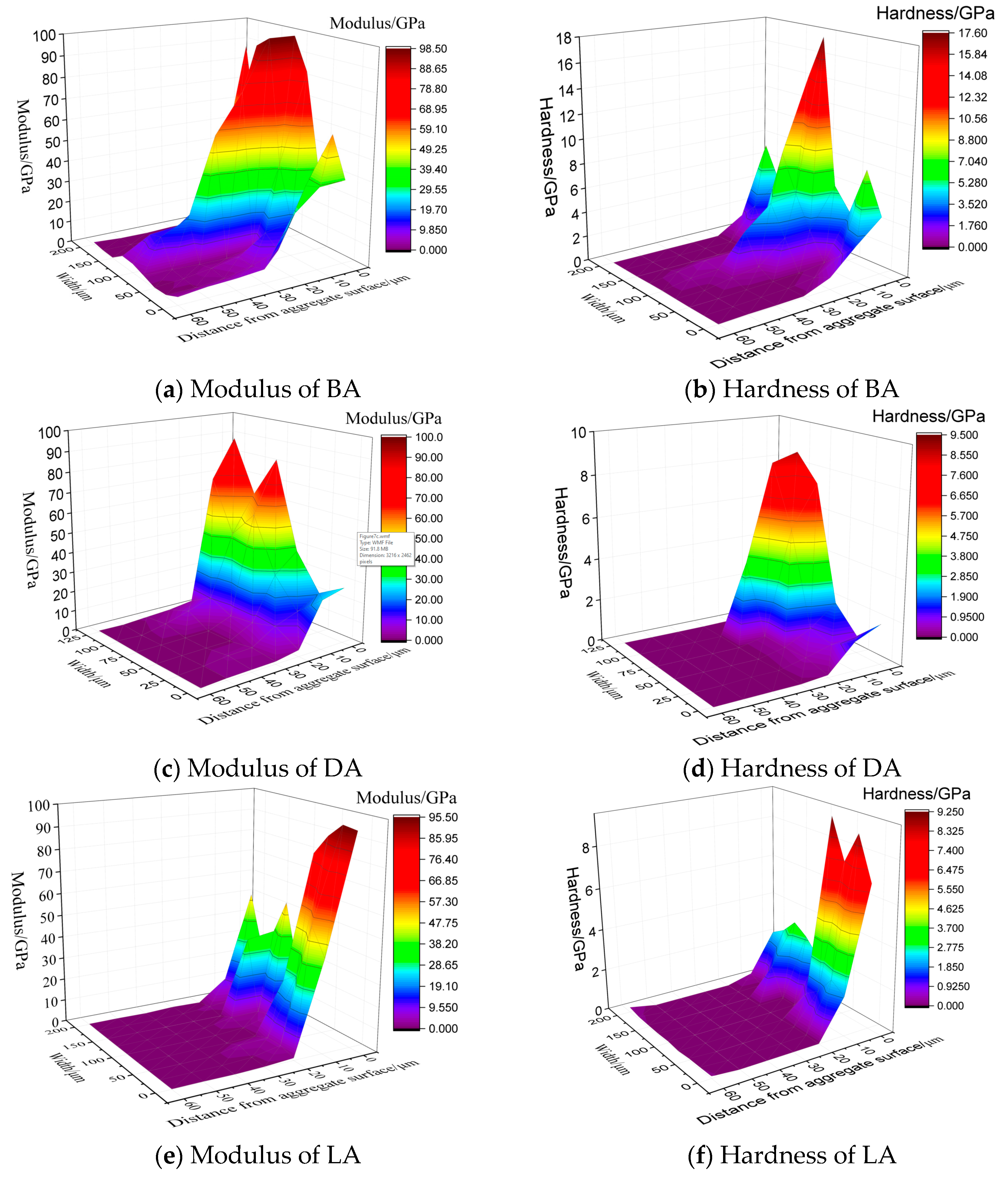
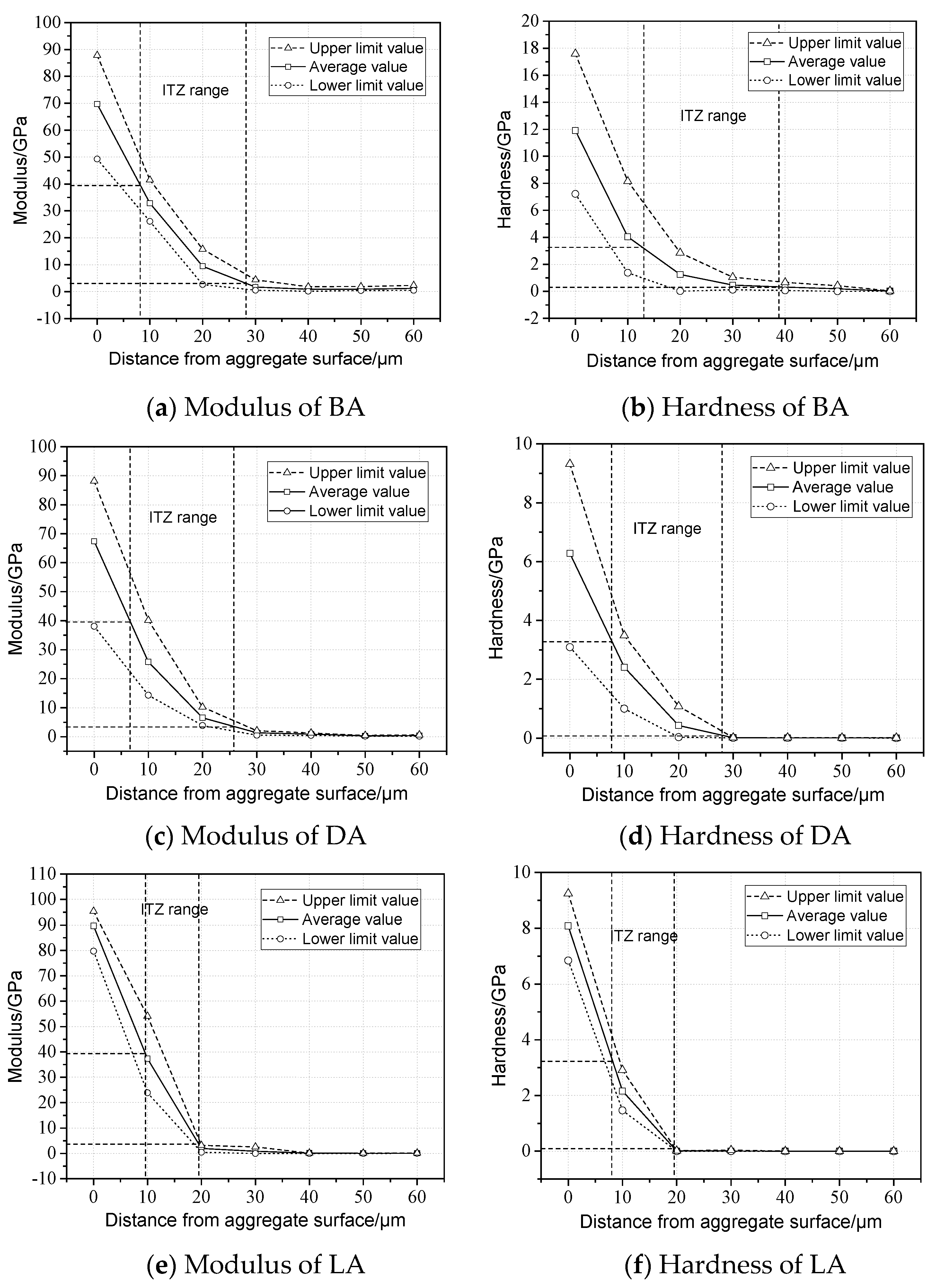
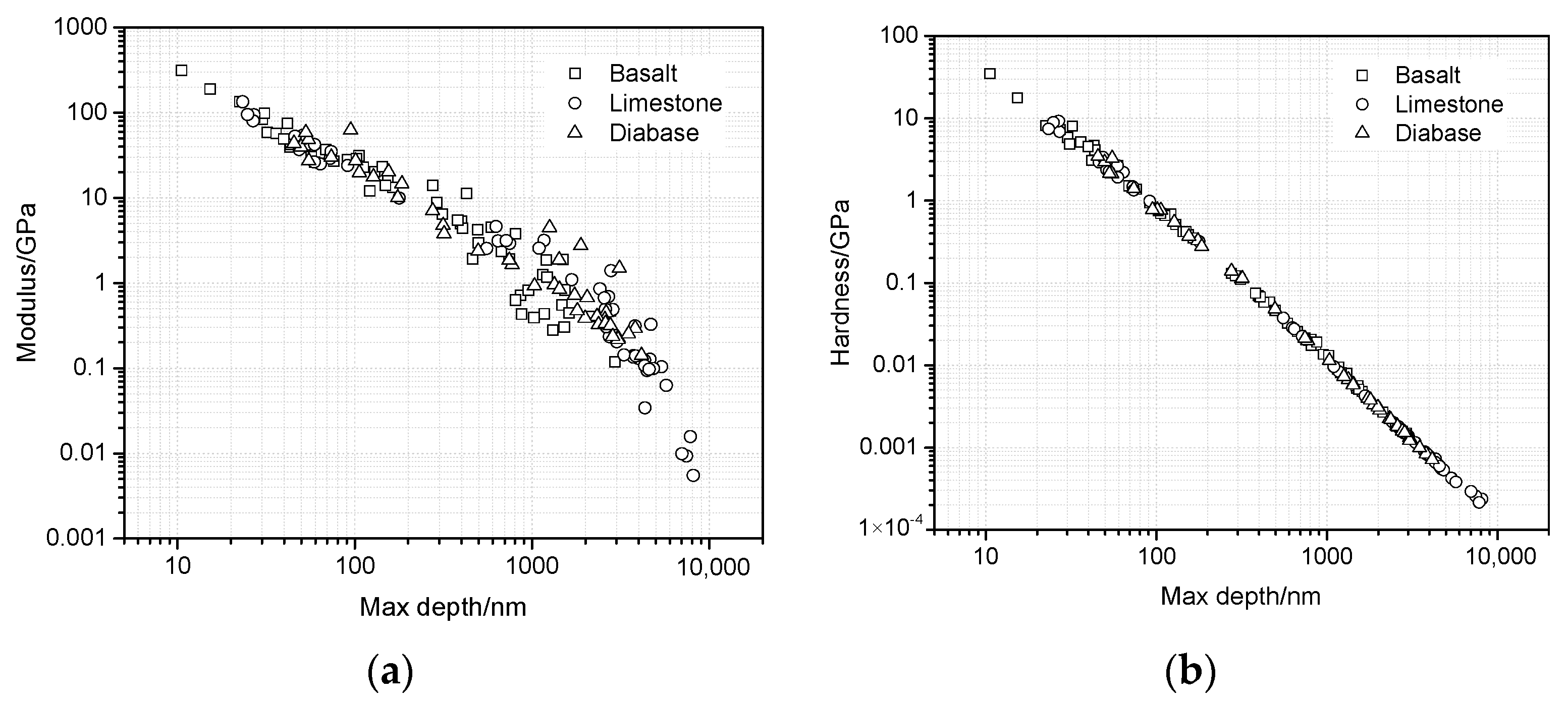
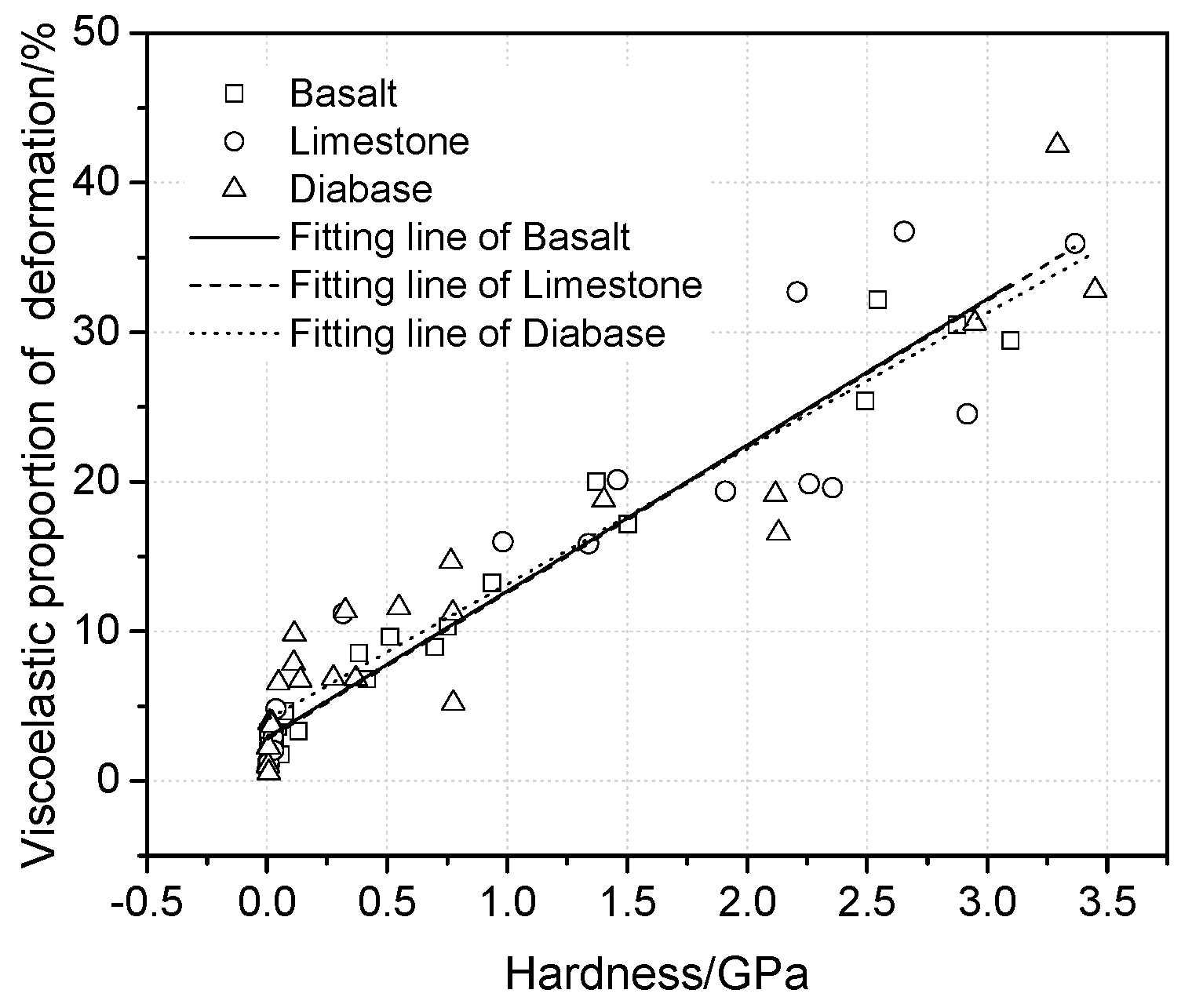
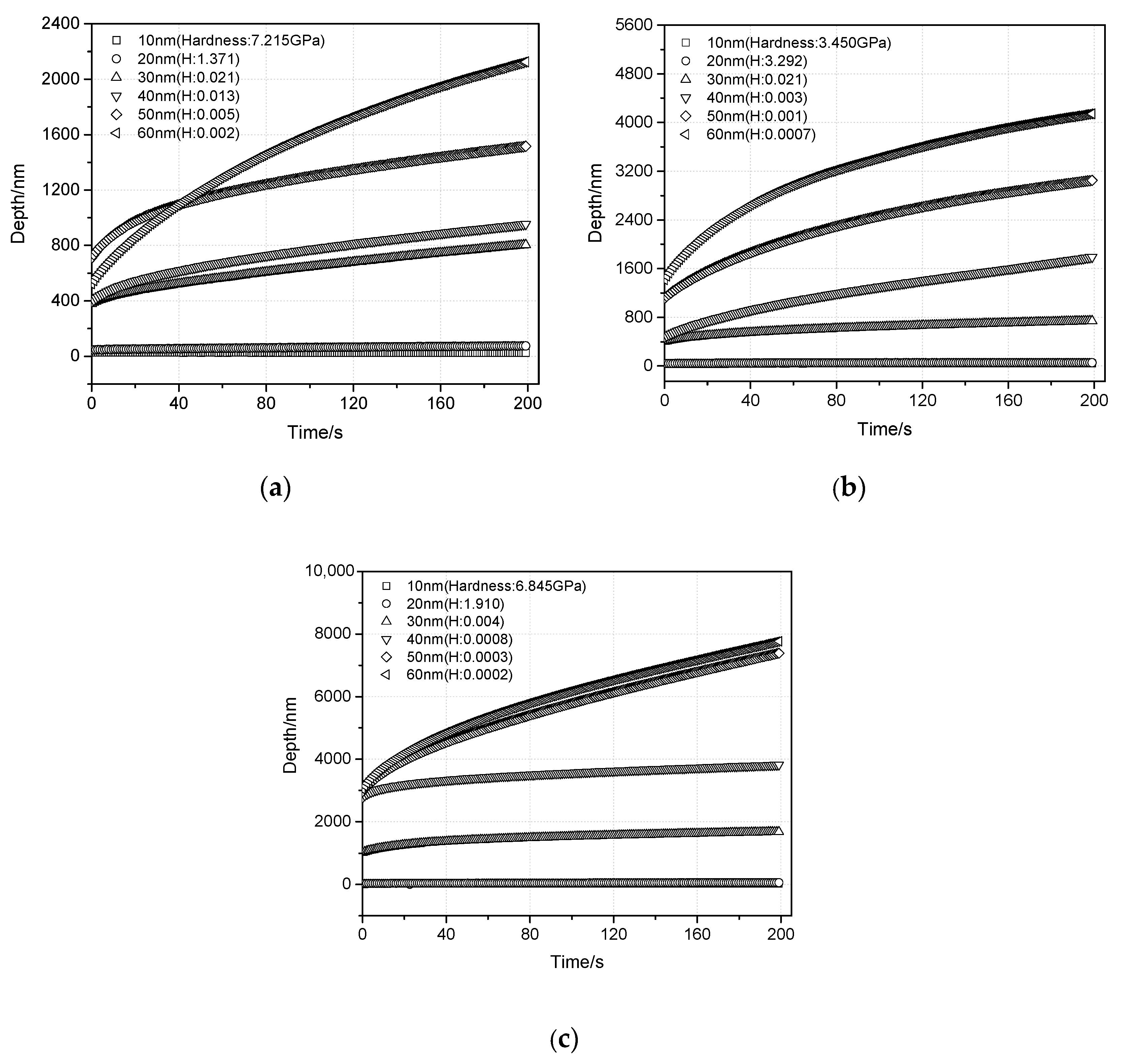
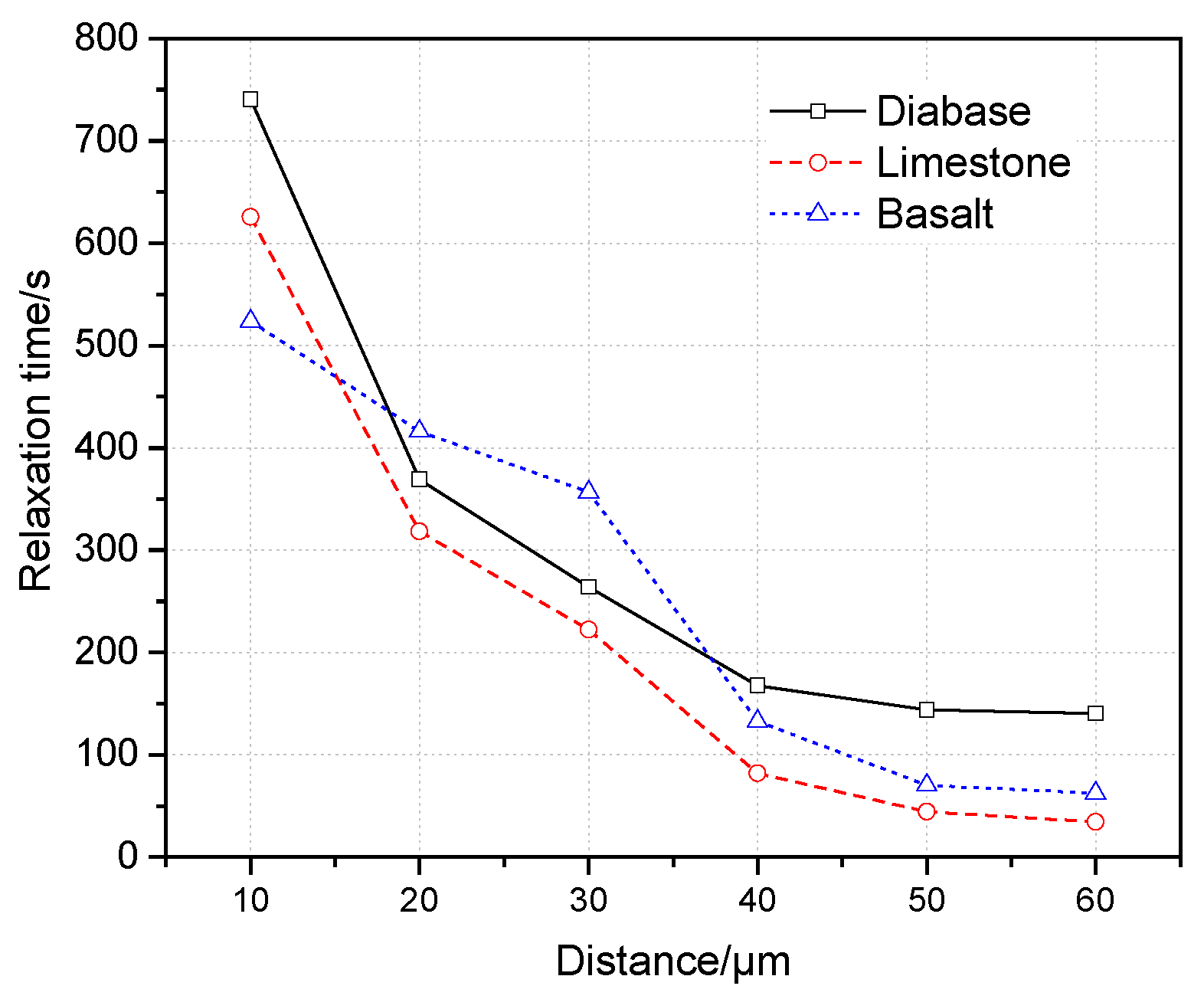
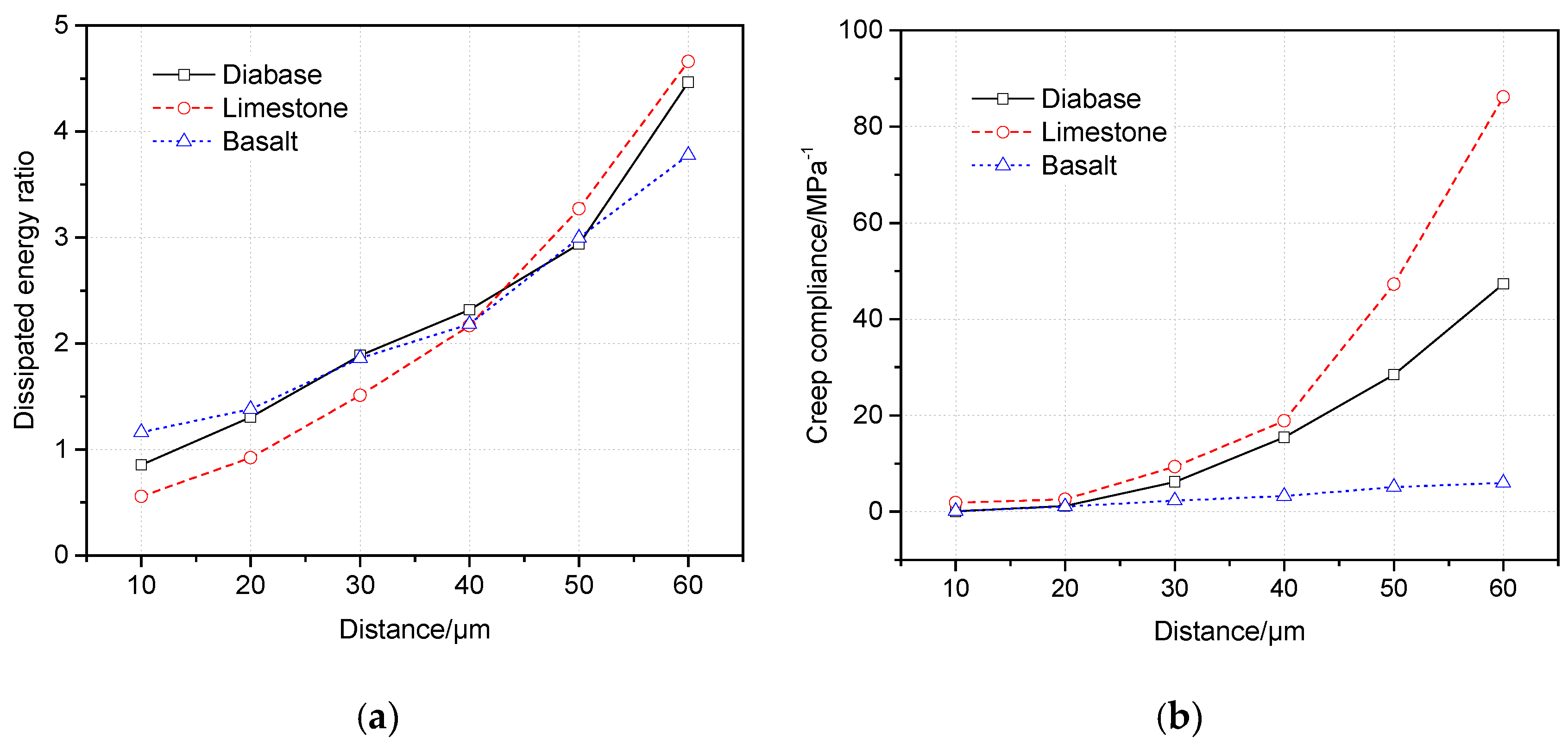



| Aggregate Type | Apparent Relative Density (g/cm3) | Water Absorption/% | Crushing Value/% | Acicular Content/% |
|---|---|---|---|---|
| Basalt | 2.946 | 0.51 | 9.6 | 0.7 |
| Diabase | 2.932 | 0.42 | 11.4 | 1.2 |
| Limestone | 2.881 | 0.86 | 10.4 | 5.8 |
| Aggregate Types | Mineralogical Components | Hardness/ Mohs | Desity/ g/cm3 | Molecular Formula | Weight/% | Volume/% |
|---|---|---|---|---|---|---|
| Basalt | Labradorite | 6.0~6.5 | 2.65~2.75 | NaAlSi3O8 CaAl2Si3O8 | 85.7 | 88.2 |
| Augite | 5.5~6.0 | 3.20~3.60 | Ca(Mg,Fe,Al)[(Si,Al)2O6] | 12.2 | 10.0 | |
| Other | – | – | – | 2.1 | 1.8 | |
| Diabase | Clinochlore | 2.0~3.0 | 2.61~3.30 | (Mg,Fe)4.75Al1.25(Al1.25Si2.75O10)(OH)8 | 63.9 | 63.7 |
| Albite | 6.0~6.5 | 2.61~2.64 | Na2O·Al2O3·6SiO2 | 18.9 | 20.6 | |
| Other | – | – | – | 14.4 | 12.8 | |
| Limestone | Calcite | 2.7~3.0 | 2.60~2.80 | CaCO3 | 95.6 | 95.5 |
| Other | – | – | – | 4.4 | 4.5 |
| Specification | Unit | SBS-Modified Asphalt |
|---|---|---|
| Penetration (25 °C, 100 g, 5 s) | mm | 5.4 |
| Ductility (5 °C, 5 cm/min) | cm | 27 |
| Softening point | °C | 74 |
| Viscosity (135 °C) | Pa∙s | 1.92 |
© 2020 by the authors. Licensee MDPI, Basel, Switzerland. This article is an open access article distributed under the terms and conditions of the Creative Commons Attribution (CC BY) license (http://creativecommons.org/licenses/by/4.0/).
Share and Cite
Hu, J.; Huang, Q.; Lou, N.; Luo, S. Microstructural Characteristics of Interfacial Zone in Asphalt Mixture Considering the Influence of Aggregates Properties. Materials 2020, 13, 2558. https://doi.org/10.3390/ma13112558
Hu J, Huang Q, Lou N, Luo S. Microstructural Characteristics of Interfacial Zone in Asphalt Mixture Considering the Influence of Aggregates Properties. Materials. 2020; 13(11):2558. https://doi.org/10.3390/ma13112558
Chicago/Turabian StyleHu, Jing, Qibo Huang, Ning Lou, and Sang Luo. 2020. "Microstructural Characteristics of Interfacial Zone in Asphalt Mixture Considering the Influence of Aggregates Properties" Materials 13, no. 11: 2558. https://doi.org/10.3390/ma13112558




